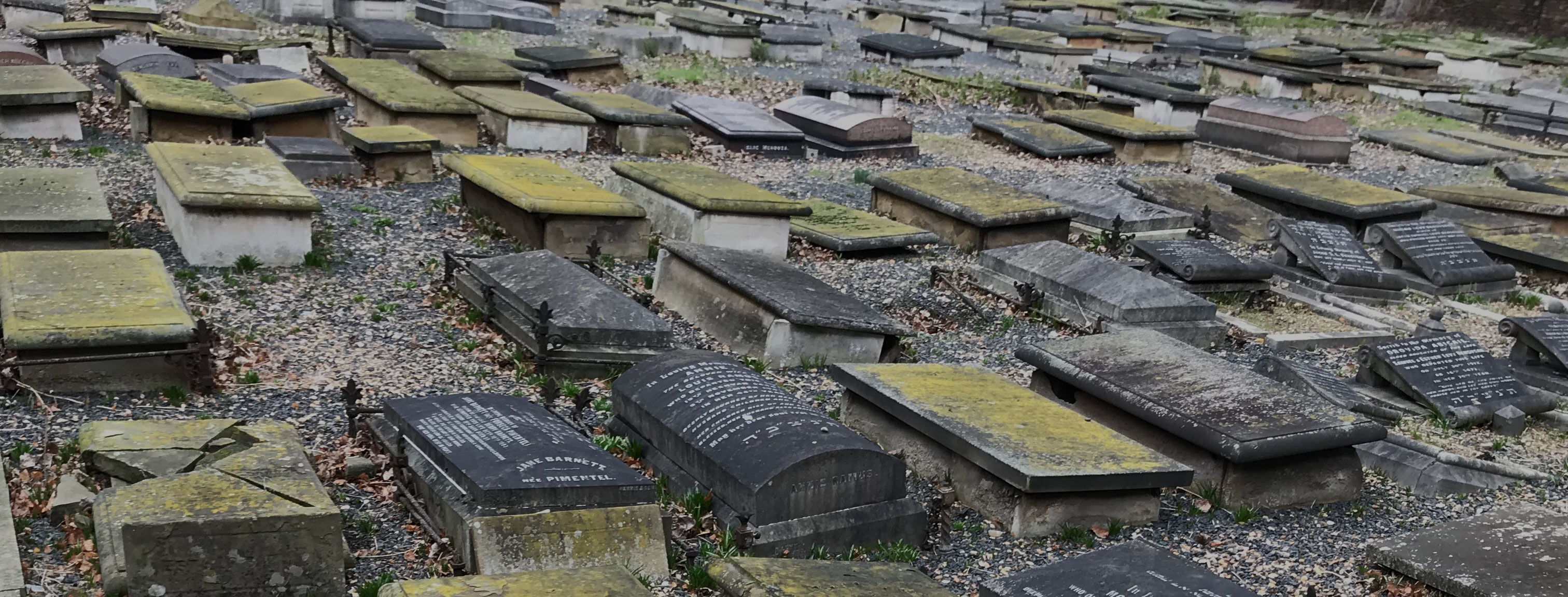
Novo Cemetery
The One Lost Stone section of this website takes huge inspiration from the Novo Cemetery.
Before the Novo Cemetery existed, the Velho Cemetery was established on the site of a former orchard in 1657, and was the first post-Resettlement burial ground. It stood a mile and a half to the east of Aldgate, in what was then known as Mile End Old Town. An adjacent site, on the now Alderney Road, was used from 1696 as a cemetery by London’s growing Ashkenazi (Eastern European Jewish) community.
By the beginning of the 18th century, the Velho was nearly full. Plans were made for a second, much larger Sephardi burial ground nearby. In 1726, about 400 metres to the east of the Velho, another former orchard, was leased by the Sephardi community.

courtesy of Locating London’s Past
The first burials at the Novo or Novo (new) cemetery took place in 1733, and a mortuary chapel or ohel was built near the southern entrance. Over the next hundred and fifty years, most Sephardi burials in London took place here. These included Diego Pereira, Baron Aguilar (1699-1759), financier and adviser to the Austrian Empress Maria Theresa; the merchant Benjamin D’Israeli (1730-1816), grandfather of the Victorian prime minister, and Daniel Mendoza (1764-1836), celebrated prize-fighter and author of the first English boxing textbook.
By the middle of the 19th century, another expansion became necessary, and in 1855 a further 1.7 acres were added to the east, between the pre-existing cemetery and the Regent’s Canal. Those buried here include the comic actor David Belasco, alias David James (1839-93); Joseph Elmaleh (1809-86), chief rabbi of Mogador and Austrian consul in Morocco, and several members of the prestigious Montefiore family. By the end of the century, London’s more affluent Sephardim had moved away from the City and East End and, in 1897 the Novo was effectively superseded by a new Sephardi burial ground at Hoop Lane in Golders Green. The north-eastern part of the Novo remained open for adult burials until 1906, and for child burials until 1918 with a few interments continuing into the 1970s.
The area immediately to the west of the Novo had, meanwhile, become the home of Queen Mary College, the successor to the ‘People’s Palace’ of 1887. It is now a part of the University of London. The college had also outgrown its site, and negotiations to acquire and develop the now-defunct cemetery had been under way since the 1940s, although legal obstacles and objections by some members of the Jewish community delayed purchase until 1972. The ‘old’ (1733) part of the Novo was cleared, with the remains of over 7,000 bodies buried in a pit on college-owned land near Brentwood in Essex. The 1855 portion of the cemetery,largely escaped redevelopment, becoming a fenced-off enclave surrounded by the new library and faculty buildings of the expanded college, which holds a 999-year lease on the site. Re-landscaping of the grounds happened in 2011 by Andrew Abdulezer of Seth Stein Architects, in collaboration with the Spanish and Portuguese Jews’ Congregation of London.
Our multimedia, interactive website One Lost Stone takes inspiration and location from Novo Cemetery. On Sunday 5th July 2020 we will be launching the website, with film, performance, poetry, research, exciting stories, music and more, based on the lives and the histories of those buried there and of those who remember them.
For more information on how you can get involved with the project go to our Get Involved page.
With special thanks to Historic England for providing most of the source material for this webpage. For further information click here

